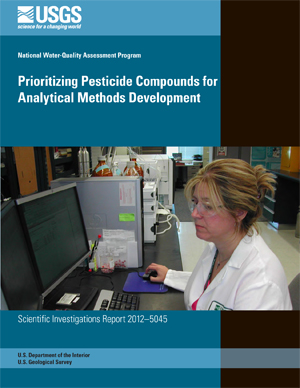 Abstract
Abstract
The U.S. Geological Survey (USGS) has a periodic need to re-evaluate pesticide compounds in terms of priorities for inclusion in monitoring and studies and, thus, must also assess the current analytical capabilities for pesticide detection. To meet this need, a strategy has been developed to prioritize pesticides and degradates for analytical methods development. Screening procedures were developed to separately prioritize pesticide compounds in water and sediment. The procedures evaluate pesticide compounds in existing USGS analytical methods for water and sediment and compounds for which recent agricultural-use information was available. Measured occurrence (detection frequency and concentrations) in water and sediment, predicted concentrations in water and predicted likelihood of occurrence in sediment, potential toxicity to aquatic life or humans, and priorities of other agencies or organizations, regulatory or otherwise, were considered.
Several existing strategies for prioritizing chemicals for various purposes were reviewed, including those that identify and prioritize persistent, bioaccumulative, and toxic compounds, and those that determine candidates for future regulation of drinking-water contaminants. The systematic procedures developed and used in this study rely on concepts common to many previously established strategies. The evaluation of pesticide compounds resulted in the classification of compounds into three groups: Tier 1 for high priority compounds, Tier 2 for moderate priority compounds, and Tier 3 for low priority compounds.
For water, a total of 247 pesticide compounds were classified as Tier 1 and, thus, are high priority for inclusion in analytical methods for monitoring and studies. Of these, about three-quarters are included in some USGS analytical method; however, many of these compounds are included on research methods that are expensive and for which there are few data on environmental samples. The remaining quarter of Tier 1 compounds are high priority as new analytes. The objective for analytical methods development is to design an integrated analytical strategy that includes as many of the Tier 1 pesticide compounds as possible in a relatively few, cost-effective methods.
More than 60 percent of the Tier 1 compounds are high priority because they are anticipated to be present at concentrations approaching levels that could be of concern to human health or aquatic life in surface water or groundwater. An additional 17 percent of Tier 1 compounds were frequently detected in monitoring studies, but either were not measured at levels potentially relevant to humans or aquatic organisms, or do not have benchmarks available with which to compare concentrations. The remaining 21 percent are pesticide degradates that were included because their parent pesticides were in Tier 1. Tier 1 pesticide compounds for water span all major pesticide use groups and a diverse range of chemical classes, with herbicides and their degradates composing half of compounds. Many of the high priority pesticide compounds also are in several national regulatory programs for water, including those that are regulated in drinking water by the U.S. Environmental Protection Agency under the Safe Drinking Water Act and those that are on the latest Contaminant Candidate List.
For sediment, a total of 175 pesticide compounds were classified as Tier 1 and, thus, are high priority for inclusion in analytical methods available for monitoring and studies. More than 60 percent of these compounds are included in some USGS analytical method; however, some are spread across several research methods that are expensive to perform, and monitoring data are not extensive for many compounds. The remaining Tier 1 compounds for sediment are high priority as new analytes. The objective for analytical methods development for sediment is to enhance an existing analytical method that currently includes nearly half of the pesticide compounds in Tier 1 by adding as many additional Tier 1 compounds as are analytically compatible.
About 35 percent of the Tier 1 compounds for sediment are high priority on the basis of measured occurrence. A total of 74 compounds, or 42 percent, are high priority on the basis of predicted likelihood of occurrence according to physical-chemical properties, and either have potential toxicity to aquatic life, high pesticide useage, or both. The remaining 22 percent of Tier 1 pesticide compounds were either degradates of Tier 1 parent compounds or included for other reasons. As with water, the Tier 1 pesticide compounds for sediment are distributed across the major pesticide-use groups; insecticides and their degradates are the largest fraction, making up 45 percent of Tier 1. In contrast to water, organochlorines, at 17 percent, are the largest chemical class for Tier 1 in sediment, which is to be expected because there is continued widespread detection in sediments of persistent organochlorine pesticides and their degradates at concentrations high enough for potential effects on aquatic life. Compared to water, there are fewer available benchmarks with which to compare contaminant concentrations in sediment, but a total of 19 Tier 1 compounds have at least one sediment benchmark or screening value for aquatic organisms. Of the 175 compounds in Tier 1, 77 percent have high aquatic-life toxicity, as defined for this process.
This evaluation of pesticides and degradates resulted in two lists of compounds that are priorities for USGS analytical methods development, one for water and one for sediment. These lists will be used as the basis for redesigning and enhancing USGS analytical capabilities for pesticides in order to capture as many high-priority pesticide compounds as
possible using an economically feasible approach.